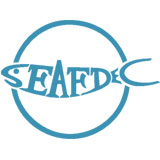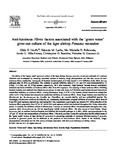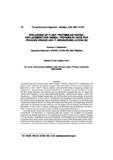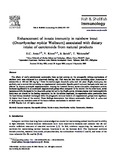Yeasts as food organisms in aquaculture
Share
Abstract
The use of yeast as feed in aquaculture is discussed. It has been successfully used as feed for Penaeus japonicus larvae, for Brachionus plicatilis mass culture, and for the improvement of nutritional quality of Tigriopus japonicus. It has been found most effective as supplemental food when enough phytoplankton cannot be supplied.
Suggested Citation
Villegas, C. T. (1982). Yeasts as food organisms in aquaculture. In Report of the Training Course on Growing Food Organisms for Fish Hatcheries: Tigbauan, Iloilo, Philippines, 3-22 August 1981 (pp. 77–80). Manila, Philippines: South China Sea Fisheries Development and Coordinating Programme.
Subject
Collections
Related items
Showing items related by title, author, creator and subject.
-
Anti-luminous Vibrio factors associated with the ‘green water’ grow-out culture of the tiger shrimp Penaeus monodon
Lio-Po, Gilda D.; Leaño, Eduardo M.; Peñaranda, Ma. Michelle D.; Villa-Franco, Annie U.; Sombito, Christopher D.; Guanzon, Nicholas G., Jr. (Elsevier, 2005)The ability of the “green water” grow-out culture of the tiger shrimp Penaeus monodon to prevent outbreaks of Luminous Vibriosis was investigated by screening associated isolates of bacteria, fungi, phytoplankton and fish ... -
Evaluation of plant proteins as partial replacement for animal proteins in diets for Penaeus indicus and P. merguiensis juveniles
Peñaflorida, Veronica D. (Society of Israeli Aquaculture and Marine Biotechnology, 2002)The growth rate and survival of two white shrimps, Penaeus indicus and P. merguiensis, fed diets in which fishmeal was partially replaced with plant protein sources were investigated in three trials. In trial 1 with P. ... -
Enhancement of innate immunity in rainbow trout (Oncorhynchus mykiss Walbaum) associated with dietary intake of carotenoids from natural products
Amar, Edgar C.; Kiron, V.; Satoh, S.; Watanabe, T. (Elsevier, 2004)The effects of orally administered carotenoids from natural sources on the non-specific defense mechanisms of rainbow trout were evaluated in a nine-week feeding trial. Fish were fed four diets containing either β-carotene ...





